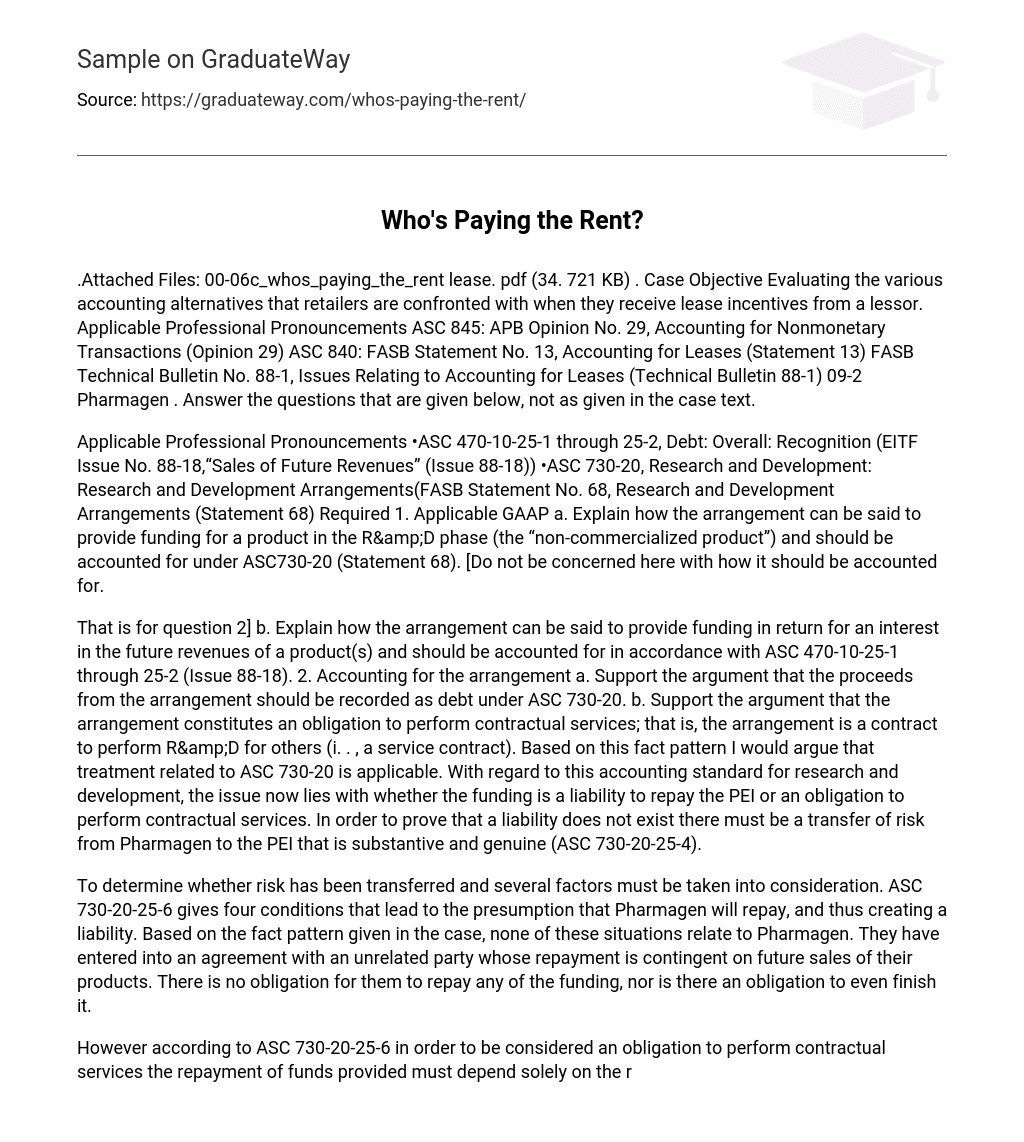To determine whether risk has been transferred and several factors must be taken into consideration. ASC 730-20-25-6 gives four conditions that lead to the presumption that Pharmagen will repay, and thus creating a liability. Based on the fact pattern given in the case, none of these situations relate to Pharmagen. They have entered into an agreement with an unrelated party whose repayment is contingent on future sales of their products. There is no obligation for them to repay any of the funding, nor is there an obligation to even finish it.
However according to ASC 730-20-25-6 in order to be considered an obligation to perform contractual services the repayment of funds provided must depend solely on the result of the R&D having future economic benefit. Since the PEI has a contingency relating to the sales of an existing commercial drug the repayment is not solely reliant on the development of drug X. Therefore Pharmagen is not transferring all financial risk to the PEI and funding must be recorded as a liability. Pharmagen accounts for the funding as a charge to R&D costs as incurred (ASC 730-20-25-7).
Following the guidance provided by ASC 730-20 is the best option for the fact pattern because of the high risk of potential failure for the product. Another way to account for the R&D funding is played out in ASC 470-10-25. If there was not so much uncertainty involved in the development of the product this would be the better choice for accounting for this situation. This standard applies to an entity which receives cash from an investor who in return will receive a specified percent of the revenue related to a particular product line.
The issue at hand for accounting for the funding using this method is whether it is considered debt or deferred income. The EITF lays out six factors in which if any are met, the proceeds are considered debt. The first is whether or not then transaction takes the likeness of a sale. The case could be made that because PEI is receiving a percentage of an existing drug, it is in essence a sale. The second factor deals with Pharmagen’s future involvement in the future cash flows.
Obviously since Pharmagen will retain the intellectual property rights they will be actively involved in the future cash flows. Because only one of the factors needed to be met, the funding received takes on the appearance of debt and none of the other factors need be examined. Accordingly FASB says the amounts recorded as debt should be amortized under the interest method (ASC 470-10-35-3). As stated earlier this method deals with sales of future revenues which implies the completion of the drug is probable.
Due to the large amount of risk associated with the industry, this probably will not be the best accounting option. The only other possible way of dealing with this contractual agreement that I could think of was splitting up the transaction between ASC 730-20 and 470-10. If Pharmagen was able to allocate the $500 million between the R&D of drug X and the purchase of future revenues for the already commercialized drug they would be able to apply both accounting methods to this transaction.
With regards to ASC 470-10, if Pharmagen could allocate the amount received for the contingency for their commercialized drug it would most definitely meet the characteristics of deferred income. In the case of being recognized as deferred income they Pharmagen would amortize the amount using the unite-of-revenue method. This would make sense being that it essentially would be a sale of future revenues. Now that the contingency based on sales of a current drug is accounted for, Pharmagem would be able to record the remaining funding as an obligation to perform contractual services in accordance to (ASC 730-20).
Without the contingency they are able prove the transfer of risk was substantive and genuine; being that the repayment of the PEI’s investment relies solely on the outcome of the production of drug X. Also since they are not related parties, there is no penalty for cancellation, and the project is not near completion the funding should be expensed to R&D and the royalty payments are treated as an offset to the expense. This would most likely be the ideal option if Pharmagen was able to allocate the funding to each situation.
However because the case does not specify whether the amounts are allocable to each specific unit this method cannot be used. When looking at investor funding of R&D there are several factors in determining the treatment related to the transaction. It seems that there is no right or wrong answer when determining whether ASC 730-20 or 470-10 applies to the situation. Companies should evaluate all the factors and choose the method that is best for the company and its investors.





